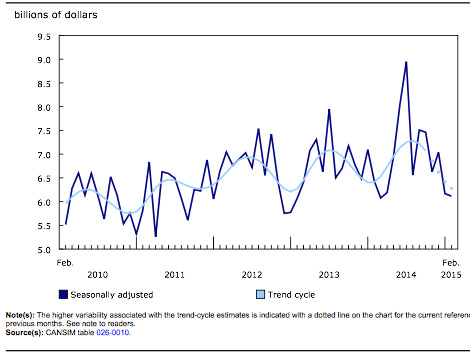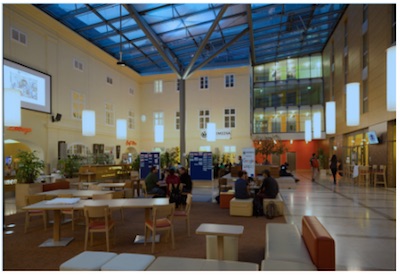Building Permits Edge Down in February

Canadian municipalities issued building permits worth $6.1 billion in February, edging down 0.9% from the previous month. This was the second consecutive monthly decline. Lower construction intentions in Quebec, Ontario and Alberta were responsible for the decrease at the national level.
Chart 1: Total value of permits
The value of permits in the non-residential sector fell 5.4% to $2.0 billion in February, marking the second decrease in three months. Quebec and Alberta accounted for much of the decline in non-residential building construction intentions. Ontario registered the biggest gain, followed by British Columbia.
In February, the value of residential building permits rose 1.5% to $4.1 billion, following an 8.1% decline in January. The increase stemmed from higher construction intentions in six provinces, led by Quebec, followed by British Columbia and Nova Scotia. Ontario saw the largest decline in the residential sector.
Non-residential sector: lower construction intentions for institutional and commercial buildings
Municipalities issued $377 million worth of institutional building permits in February, down 20.5% from January and the second straight monthly decline. The decrease came from a variety of buildings, including educational institutions, government buildings, medical facilities and retirement homes. Declines were recorded in five provinces, led by Quebec. British Columbia registered the largest increase.
In the commercial component, the value of permits fell for a second consecutive month, down 6.2% to $1.2 billion in February. Decreases were posted in three provinces, led by Quebec, followed by Alberta and Newfoundland and Labrador. Nationally, the decline came from lower construction intentions for recreational facilities and, to a lesser degree, warehouses. Ontario registered the largest increase in the component.
The value of permits issued for industrial buildings rose 19.2% to $399 million in February, following a 23.2% decline the previous month. The increase resulted mostly from higher construction intentions for transportation-related buildings and primary industry facilities in Ontario. The gain in Ontario was sufficiently large to offset the declines in seven provinces, with British Columbia and Alberta registering the largest decreases.
Chart 2: Residential and non-residential sectors

Residential sector: Higher construction intentions for multi-family dwellings
The value of multi-family dwelling permits increased 20.7% to $1.8 billion in February, ending a string of four consecutive monthly declines. The advance was attributable to higher construction intentions in every province except Ontario. Quebec posted the largest advance, followed by British Columbia and Nova Scotia.
Construction intentions for single-family dwellings declined 9.6% to $2.3 billion, following two consecutive monthly increases. The decrease came from lower construction intentions in every province except Nova Scotia, which posted a slight increase. Quebec, Alberta, British Columbia and Ontario accounted for most of the decline.
Canadian municipalities approved the construction of 15,133 new dwellings in February, up 2.7% from January. The increase was a result of a 9.4% gain in the number of multi-family dwellings to 9,325 units. The number of single-family dwellings declined 6.6% to 5,808 units.
Quebec, Ontario and Alberta post large declines
The total value of permits was down in four provinces in February, with Quebec posting the largest decline, followed by Ontario and Alberta.
The large decrease in Quebec occurred as a result of lower construction intentions for commercial and institutional buildings, as well as single-family dwellings. While the value of multi-family dwelling permits issued in Quebec increased significantly, it was not enough to offset declines in the other components.
In Ontario, the decline was attributable to lower construction intentions for residential buildings, mainly multi-family dwellings. In Alberta, the decrease came mostly from single-family dwellings and commercial buildings.
In contrast, the largest gain occurred in British Columbia, where multi-family dwellings and, to a lesser extent, commercial and institutional buildings were responsible for the advance. The increase in Nova Scotia resulted largely from higher construction intentions for multi-family dwellings.
Higher construction intentions in most census metropolitan areas
The total value of building permits was up in 23 of the 34 census metropolitan areas in February, with Vancouver, Kitchener–Cambridge–Waterloo and Halifax posting the largest increases.
In Vancouver, the increase resulted from higher construction intentions for multi-family dwellings, as well as commercial and institutional buildings. In Kitchener–Cambridge–Waterloo, multiple dwellings and commercial buildings largely explained the increase, while in Halifax, higher construction intentions for multi-family dwellings accounted for most of the gain in February.
Conversely, Toronto and Montréal registered the largest decreases. In Toronto, the decline originated from lower construction intentions for multiple dwellings and, to a lesser degree, single-family houses as well as institutional buildings. In Montréal, which had the biggest gain the previous month, the decrease came from commercial and institutional buildings, as well as single-family dwellings.
Source: Statistics Canada, http://www.statcan.gc.ca/daily-quotidien/150409/dq150409a-eng.htm?cmp=mstatcan.
















